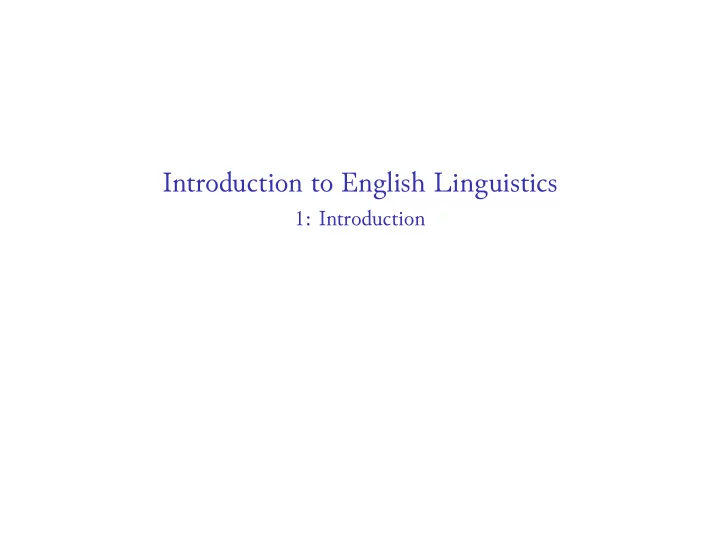

Introduction to English Linguistics 1: Introduction
Linguistics or Medieval Studies? Figure: Wahlpflicht between linguistics and medieval studies
Language
Language and Thought Figure: CC BY-NC-ND TED
Past Language
Past Language Figure: (c) Oxford, Bodleian Libraries, MS Cotton Junius 11, p. 103 (detail)
Clues to Historical Spoken Language ▶ Known pseudophonetic script (e.g. Roman alphabet) ▶ Poetic constraints (metre, rhyme, alliteration) ▶ Historical reference languages (Old Saxon, Old High German) ▶ Later spelling and pronunciation (e.g. current English) ▶ Regular development
The First English Speakers? Figure: Homelands and Settlements (CC-BY-SA WMC user)
Runic Script Figure: Anglo-Frisian runes ▶ Anglo-Frisian Futhorc, ss. �–�i, 29–33 graphemes
Inflectional Levelling OE ME hȳran hēren wē hȳraþ wē hēren þæt wē hȳren þat wē hēren þā dagas þē daies þāra daga of þē daies on þǣm dagum in þē daies Table: Inflectional levelling in Middle English
Morphology: A Foretaste Morpheme The smallest meaning-carrying unit of language ▶ Free: can form a word by itself ▶ Lexical: Refers to sth outside of language ( fish ) ▶ Functional: Mainly grammatical reference ( the , of ) ▶ Bound: Cannot form a word by itself ▶ Inflectional: conveys grammatical information ( -s , -d ) ▶ Derivational: changes a word’s sense or grammatical category ( dis- , -ly )
Language Types ▶ Isolating: a low morpheme-per-word ratio, and no inflectional morphemes ▶ Analytic: a low morpheme-per-word ratio (Mandarin, MnE) ▶ Synthetic: a high morpheme-per-word ratio ▶ Fusional: overlays units of meaning (Latin, German, OE) ▶ Agglutinative: serializes units of meaning (Finnish)
Transitional Characteristics (Selective) Old to Middle English (c. 1150) ▶ Inflectional levelling ( bacan > bāken ) Middle to Modern English (c. 1500) ▶ Inflectional loss ( bāken > bake ) ▶ Great Vowel Shifu
The Great Vowel Shifu (c. 1350–c. 1700) Figure: The Great Vowel Shifu in overview
Periodization of English 1. c. 450–c. 1150: Old English (OE) 1.1 c. 450–c. 700: Proto-English (PE) 1.2 c. 700–c. 1150: Old English (OE) 2. c. 1150–c. 1500: Middle English (ME) 3. c. 1500–present: Modern English (MnE) 3.1 c. 1500–c. 1700: Early Modern English (eMnE) 3.2 c. 1700–present? Late Modern English (lMnE) cf. Present-Day-English (PDE)
Linguistics
(Some) Linguistic Disciplines ▶ Phonetics ▶ Phonology ▶ Morphology ▶ Word Formation ▶ Syntax ▶ Lexicology ▶ Semiotics ▶ Semantics ▶ Etymology ▶ Pragmatics ▶ Dialectology ▶ Sociolinguistics
Traditional Parts of Speech of English ▶ Noun ▶ Adjective ▶ Pronoun ▶ Verb ▶ Adverb ▶ Preposition ▶ Conjunction ▶ Interjection ▶ (Numeral) ▶ (Determiner)
Traditional Parts of Speech of English ▶ Noun: case, number, gender ▶ Adjective: case, number, gender ▶ Pronoun: case, number, gender ▶ Verb: person, number, tense, mood, voice, aspect ▶ Adverb ▶ Preposition ▶ Conjunction (coordinating; subordinating) ▶ Interjection ▶ (Numeral) ▶ (Determiner)
Bibliography Barber, Charles, Joan C. Beal, and Philip A. Shaw. The English Language . 2nd ed. Cambridge: Cambridge University Press, 2009. Mair, Christian. English Linguistics: An Introduction . 3rd ed. Tübingen: Narr, 2015. P . S. Langeslag
Recommend
More recommend